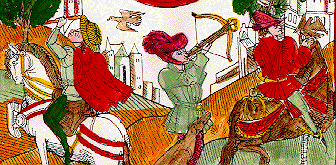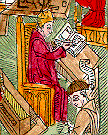
Introduction to Blockbooks
The Children of Jupiter - detail
An Introduction to Blockbooks
What is a Blockbook?
A blockbook is a book made up from pages which have been printed entirely -
both pictures and text - from woodcut blocks.
Blockbooks of mid-fifteenth century Europe were often printed, not with
a press, but by laying the sheet of paper over the inked block and rubbing
the back of the paper with some rounded object (a "rubber" or "burnisher")
to transfer the ink. (The technique will be familiar to many people who
have done some introductory experiments in printing, perhaps in school art
classes.) When you print this way, you can only print on one side of the
sheet, since the rubbing of the "verso" would damage the printing on the
"recto". A common way of binding books printed with this technique
involved stacking the sheets so that alternate openings of the book would
reveal a pair of printed pages, then a pair of blank backs. These blank
openings were frequently glued closed.
Why Blockbooks?
The blockbook technology was not, as you might imagine, an early stage of
printing from which printing with moveable type evolved. In fact, the age of
the blockbook in Europe was contemporary with the first two or three decades
of printing from moveable type; most blockbooks are dated in the 1450's,
60's or 70's. The appearance and persistence of this rather painstaking
technology in the face of what has proved to be a superior way to print, can
be explained on economic grounds.
Although it is more versatile to have a font (or several fonts) of type
and a stock of blocks which can be used in more than one publication, or
several times in the same publication, blockbook printing does not require
the publisher to own either type fonts or press. In addition, one can
conveniently print in small editions, without incurring the labor cost of
setting the type. This reduces tremendously the financial risk of printing
at a time when the cost of paper was a major factor in the economics of
publishing (Hindman). (Modern technology has produced the potential for an
analogous situation, with the emergence of publication-on-demand formats.)
In addition, the reading public (whose tastes, preconceptions, and
prejudices publishers are known to have catered to) must have found the
appearance of the blockbook familiar, with its manuscript-like text and
its vivid coloring over a print which resembled a sketch.

Children of Mercury - detail
Sources and Further Reading
Blockbuecher des Mittelalters : Bilderfolgen als Lektuere.
Exhibition catalog, Mainz, Gutenberg-Museum, June-September 1991. Mainz:
Von Zabern, 1991.
Hind, Arthur Mayger. An Introduction to a History of Woodcut,
with a Detailed Survey of Work Done in the Fifteenth Century.
New York: Dover Publications, 1963.
Hindman, Sandra L., ed. Printing the Written Word: The Social
History of Books, circa 1450-1520. Ithaca: Cornell University
Press, 1991.
Palmer, Nigel F., ed. Apokalypse, Ars moriendi, Biblia
pauperum, Antichrist, Fabel vom Kranken Loewen, Kalendarium und
Planetenbuecher, Historia David : Die Lateinisch-Deutschen Blockbuecher
des Berlin- Breslauer Sammelbandes : Staatliche Museeun zu Berlin,
Preussischer Kulturbesitz, Kupferstichkabinett, Cim. 1, 2, 5, 7, 9, 10,
12. Munich: H. Lengenfelder, 1992.
Schreiber, Wilhelm Ludwig and Theodore Musper. Handbuch der
Holz- und Metallschnitte des XV. Jahrhunderts. Manuel de l'Amateur de la
Gravure sur Bois et sur Metal au XVe Siecle. Stuttgart: A.
Hiersemann; Nendeln: Kraus Reprint, 1969-1976.
The Book of the Seven
Planets
Astronomy & Astrology *** Blockbooks
*** This Edition ***
The Poems






